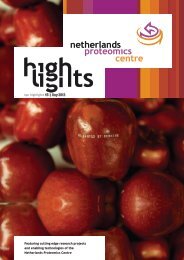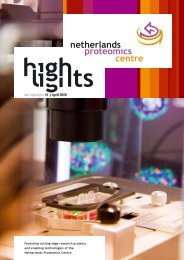NPC Valorisation Voucher - Netherlands Proteomics Centre
NPC Valorisation Voucher - Netherlands Proteomics Centre
NPC Valorisation Voucher - Netherlands Proteomics Centre
You also want an ePaper? Increase the reach of your titles
YUMPU automatically turns print PDFs into web optimized ePapers that Google loves.
Resuming protein synthesis Since eEF2K has autophosphorylationactivity [6], we hypothesised that eEF2K, once activated,may autophosphorylate its degron, thus triggering the bindingof eEF2K to βTrCP. Indeed, immunopurified wild type eEF2Kcould autophosphorylate on Ser441 and Ser445 and bind toβTrCP in vitro whereas a kinase dead eEF2K mutant could not.We then wanted to know whether βTrCP-mediated degradationof eEF2K is required to resume protein synthesis uponcheckpoint silencing. Cells expressing the degradation-resistantform of eEF2K that were exposed to genotoxic stress displayeda slower decrease in phosphorylation of eEF2 on Thr56 duringsilencing of the DNA damage checkpoint. These cells alsodisplayed a decreased rate of global protein synthesis duringcheckpoint silencing when compared to control cells.Initiation and silencing In this article we show that uponactivation of the DNA damage checkpoint, AMPK mediates theactivation of eEF2K, which in turn phosphorylates eEF2, leadingto a decrease in translation elongation rates. Subsequently,eEF2K autophosphorylation generates a phosphodegron for therecruitment of the SCF βTrCP ubiquitin ligase. This event triggersthe ubiquitylation of eEF2K and its proteasome-mediateddegradation, which releases the inhibitory effect on eEF2 andtranslation elongation (see Figure 3).Regulation of translation elongation in response to DNA damagemight have several advantages over controlling translationinitiation. Indeed, elongation inhibition during checkpoint activationavoids the disassembly of polysomes, which, by stallingribosomes on the mRNAs, might allow for mRNA protection fromdegradation or sequestration into stress granules. This mechanismwill also ensure that translation can rapidly resume whenthe checkpoint is turned off.SCF βTrCP is implicated in the degradation of several substratesduring the recovery from DNA damage and replication stresscheckpoints. Indeed, βTrCP is required to reactivate the cyclindependentkinase Cdk1 by targeting the Cdk1 inhibitors Claspinand Wee1 for proteasome-dependent degradation and turn offthe DNA repair machinery by causing the destruction of theFanconi anemia protein FANCM. Our findings show that βTrCPis also needed during checkpoint silencing to resume proteinsynthesis by triggering proteolysis of eEF2K, suggesting that theubiquitin ligase SCF βTrCP coordinates different processes (suchas cell cycle progression, DNA repair, and protein synthesis) thatare critical for checkpoint termination.References1 Arora, S. (2005) , Identification of the ubiquitin-proteasomepathway in the regulation of the stability of eukaryoticelongation factor-2 kinase. Cancer Res 65, 3806–3810.2 Low, T.Y. et al. (2012) Unraveling the ubiquitin-regulatedsignaling networks by mass spectrometry-based proteomics.<strong>Proteomics</strong> Sep 28. doi: 10.1002/pmic.201200244.[Epub ahead of print]3 Kruiswijk, F. et al. (2012) Coupled activation and degradationof eEF2K regulates protein synthesis in response togenotoxic stress. Sci Signal, 5(227):ra40.4 Meloche, S and Roux, P.P. (2012) F-box proteins elongatetranslation during stress recovery. Sci Signal, 5(227):pe25.5 Zhou, H. et al. (2011) Enhancing the identification ofphosphopeptides from putative basophilic kinase substratesusing Ti (IV) based IMAC enrichment. Mol Cell <strong>Proteomics</strong>10 (10):M110.006452.6 Diggle, T.A. et al. (1999) Analysis of the domain structureof elongation factor-2 kinase by mutagenesis. FEBS Lett,457(2):189-92.Research team| 23From left to right: Teck YewLow from the BiomolecularMass Spectrometry andContact<strong>Proteomics</strong> Group, Utrecht;Teck Yew Low, PhDDaniele Guardavaccaro,Biomolecular Mass SpectrometryFlore Kruiswijk andand <strong>Proteomics</strong> GroupRoberto Magliozzi fromKruytgebouw Z605KNAW Hubrecht Institute,Padualaan 8Utrecht3584 CH Utrecht, the <strong>Netherlands</strong>T +31 30 253 9403t.y.low@uu.nlsummaryThe kinase eEF2K controls the rate of peptide chain elongationby phosphorylating eEF2, the protein that mediates themovement of the ribosome along the mRNA by promotingtranslocation of the transfer RNA from the A to the Psite in the ribosome. eEF2K-mediated phosphorylation ofeEF2 on threonine 56 (Thr56) decreases its affinity for theribosome, thereby inhibiting elongation. Here we show thatin response to genotoxic stress, eEF2K was activated byAMPK (adenosine monophosphate–activated protein kinase)–mediated phosphorylation on serine 398. Activated eEF2Kphosphorylated eEF2 and induced a temporary ribosomalslowdown at the stage of elongation. Subsequently, duringDNA damage checkpoint silencing, a process required to allowcell cycle reentry, eEF2K was degraded by the ubiquitinproteasomesystem through the ubiquitin ligase SCF βTrCP(Skp1–Cul1–F-box protein, β-transducin repeat–containingprotein) to enable rapid resumption of translation elongation.This event required autophosphorylation of eEF2K on acanonical βTrCP- binding domain. The inability to degradeeEF2K during checkpoint silencing caused sustainedphosphorylation of eEF2 on Thr56 and delayed the resumptionof translation elongation. Our study therefore establishesa link between DNA damage signalling and translationelongation.






